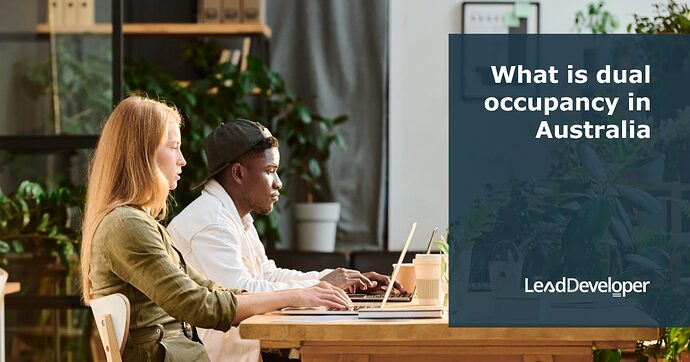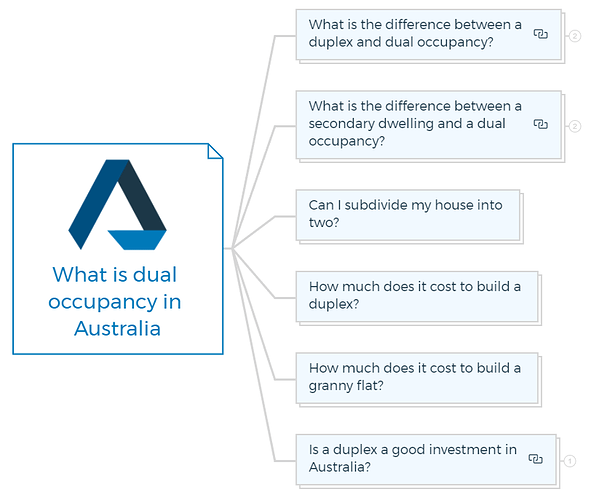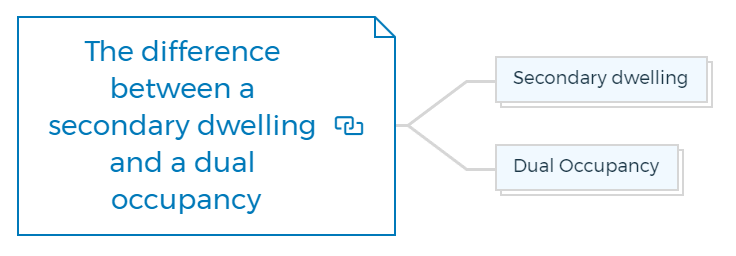What is dual occupancy in Australia?
In the past few years, Australia’s housing market has changed a lot, and dual occupancy is becoming more popular for property owners to get the most out of their investments.
Dual occupancy benefits both property developers and investors. Let’s explore more about dual occupancy in Australia.
You are missing out if you haven’t yet subscribed to our YouTube channel.
Dual occupancy in Australia, also known as dual occupancy auxiliary property or shared dwelling, refers to a property that contains two separate living spaces, usually with separate entrances. You can also understand it as two homes on one title.
Dual occupancy properties can be owned by one person or entity or separated and sold or rented individually.
Attached and detached occupancy are the two types of dual occupancy dwellings. In the attached dual occupancies, two dwellings are attached on one lot of land. While in detached occupancy, two separate dwellings are developed on one lot of land.
There are many reasons why people are considering dual occupancy in Australia. Some of them are -
- Increase the value of a property.
- An affordable option for potential home buyers.
- Provides an additional source of income.
What is the difference between a duplex and dual occupancy?
Duplex
A duplex typically refers to a building divided into two separate units that share a common wall, each with its own separate entrance.
These units are often mirror images of each other and are typically found in neighbourhoods or city areas where space is at a premium.
Two houses share a “party wall” in a duplex. This can be done on one property as a dual occupancy with a single title and landowner or as a subdivision with individual titles and owners.
Dual Occupancy
Dual occupancy homes can share a land title, but they can have separate leases and utilities and be combined into one larger house. Dual occupancy is a popular option for real estate investors who live in one home and rent out the other one to generate their side income.
What is the difference between a secondary dwelling and a dual occupancy?
A secondary dwelling (Granny flat) and a dual occupancy are similar in that they both refer to properties that have two separate living spaces; however, there is a difference in their usage and how they are regulated.
Secondary dwelling
A secondary dwelling, or a granny flat, is a smaller, self-contained living space on the same property as a larger primary residence.
The secondary dwelling is typically smaller than the primary residence and used for various purposes, such as a place for an aging parent or adult child to live or as a rental unit to generate additional income.
Dual Occupancy
Dual Occupancies are independent of the Dwelling House on the site. It can be strata-titled, sold independently from the main house, and rented on the same title. You can understand dual occupancy as a Multiple Housing complex with only 2 units.
The fundamental distinction between the two is that a secondary house is usually smaller and meant for a specific person or function, such as a caretaker. In contrast, dual occupancy can refer to any property with two different living spaces, whether attached or not.
The local government may have size, zoning, and building code requirements for secondary dwellings.
Can I subdivide my house into two?
Yes, you can subdivide your house into two separate dwellings, but it is conceivable if local zoning and building codes allow it.
Check with your local authorities to determine if your property is zoned for dual occupancy and if there are any special restrictions. Your local council must approve a development application if your property is zoned for dual occupancy or duplexes.
The development application must include subdivision drawings, specifications, and building and safety approvals.
Subdividing your land might be complicated, so you may need to employ an architect, surveyor, or town planner. The local government may charge you to handle the application.
It’s best to verify with the local authorities and hire an expert before dividing your house into two sections.
I always advise property developers to prepare a team of professionals before starting any real estate development project. This may help them to tackle any legal situations.
How much does it cost to build a duplex?
Location, size, design, materials, and labour expenses affect duplex construction costs.
Building a duplex typically costs $150,000 to $300,000, depending on the parameters mentioned.
A simple duplex with two units, each with two bedrooms and two bathrooms, plus a shared living space and kitchen, may cost $150,000 to $200,000.
A more expensive duplex with high-end finishing, spacious living spaces and numerous bedrooms and bathrooms might cost $300,000
How much does it cost to build a granny flat?
Building a granny flat or secondary dwelling depends on location, size, design, materials, and labour costs.
Building a granny flat can cost $50,000 to $150,000 or more based on the above considerations.
A one-bedroom, one-bathroom granny apartment with a modest kitchen and living space may cost $50,000 to $75,000. A more sophisticated granny flat with high-end amenities, spacious living spaces, and multiple bedrooms and bathrooms may cost $100,000
Property Development Books - “Starter-Pack”
18 Property Development Books To Get You Started Now
Includes 18 x detailed eBooks
✓ Property Development Checklist - 6 Pages
✓ How To Finance Your Property Development Project? - 13 Pages
✓ Property Development Team - 19 Pages
✓ Site Acquisition Process - 14 Pages
✓ The Ultimate Guide To Getting Started In Property Development - 42 Pages
✓ My Secret Property Development Process - 28 Pages
✓ How To Nail Your Next No Money Down Deal? - 29 Pages
✓ Industry Insiders Guide To Managing Risks In Property Development - 26 Pages
✓ How To Become A Property Developer? - 41 Pages
✓ Do You Have What It Takes To Be A Property Developer? - 12 Pages
✓ 7 Common Mistakes Made By Property Developers & How To Avoid Them? - 12 Pages
✓ 5 Reasons, Buy & Hold Property Investors Fail At Property Development - 16 Pages
✓ 10 Financial Mistakes Made By Property Investors & Developers - 54 Pages
✓ My 26 Question Due Diligence Checklist - 21 Pages
✓ Property Development 101: The Feasibility Study - 34 Pages
✓ Property Development 101: Construction Guide - 55 Pages
✓ Property Development Blueprint - 66 Pages
✓ Your Definitive Guide To Property Options - 36 Pages
Is a duplex a good investment in Australia?
In Australia, a duplex can be an excellent investment, especially for those looking to enter the property market. It is because you can live in one apartment and rent the other. This can reduce mortgage and maintenance costs.
Owning a duplex allows you to rent out one unit while living in the other or both units and use the rental revenue to offset property expenditures.
Capital growth makes duplexes a desirable investment. Property values may rise as rental property demand rises, offering a good return on investment.
A duplex’s investment potential depends on its location, demand for rental units in the neighbourhood, and condition and maintenance. Before buying, explore the local market, talk to a realtor, and analyse the investment.
Property taxes, insurance, upkeep, repairs, tenant management, and rent collection are also crucial when buying a duplex. Before investing in a duplex, verify with the local government because duplex rental laws differ by state.
Do duplexes go up in value?
Duplexes can go up in value like other real estates. Demand for rental properties, economic conditions, and maintenance can increase a duplex’s value.
The duplex’s value is more likely to rise if the local economy and rental market are strong. Well-maintained, upgraded, and well-located properties are also appreciated. Redevelopment or rezoning may also improve property value.
Real estate markets are cyclical. Therefore duplex values may change.







